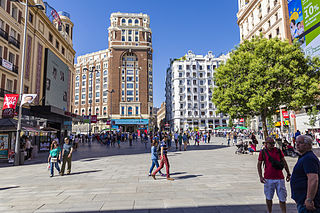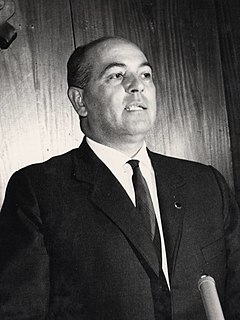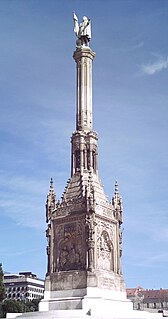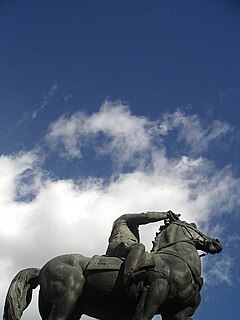 | |
 | |
| Namesake | Tirso de Molina |
|---|---|
| Type | plaza |
| Maintained by | Ayuntamiento of Madrid |
| Location | Centro, Madrid, Spain |
| Coordinates | 40°24′44″N3°42′17″W / 40.412346°N 3.704666°W |
The plaza de Tirso de Molina is a public square in the city of Madrid, Spain.
 | |
 | |
| Namesake | Tirso de Molina |
|---|---|
| Type | plaza |
| Maintained by | Ayuntamiento of Madrid |
| Location | Centro, Madrid, Spain |
| Coordinates | 40°24′44″N3°42′17″W / 40.412346°N 3.704666°W |
The plaza de Tirso de Molina is a public square in the city of Madrid, Spain.
If features a roughly triangular shape, covering an area close to 6,000 square metres. [1]
Created upon the demolition of the Convento de la Merced during the early years of the reign of Isabella II, it was inaugurated under the name of Plaza del Progreso ("Square of the Progress"), with some trees planted on the plot. [2] [3] After the 1868 Glorious Revolution, the square gained a statue of Juan Álvarez Mendizábal, precisely the minister behind the ecclesiastical confiscation. [2] After the Francoist victory in the Civil War, the statue of Mendizábal was replaced in 1943 by another one representing Gabriel Téllez (best known as "Tirso de Molina"). [4]
The square undertook a major revamp in the 2000s, seeking to reinforce its value as pedestrian area. [1] The project was authored by the Haiku Studio. The reform was inaugurated in 2006. [1]
Located it the north of Embajadores, it constitutes a reference for the latter neighborhood despite its rather small size. [1]
Tirso de Molina was a Spanish Baroque dramatist, poet and Roman Catholic monk. He is primarily known for writing The Trickster of Seville and the Stone Guest, the play from which the popular character of Don Juan originates. His work is also of particular significance due to the abundance of female protagonists, as well as the exploration of sexual issues.

The National Archaeological Museum is a museum in Madrid, Spain. It is located on Calle de Serrano beside the Plaza de Colón, sharing its building with the National Library of Spain.

Plaza Muñoz Rivera, formally Plaza Luis Muñoz Rivera, is the smaller of the two plazas at Plaza Las Delicias in the city of Ponce, Puerto Rico. It is located on the north side of Plaza Las Delicias, north of the larger southern Plaza Degetau. The square is notable for its fountains and for the Luis Muñoz Rivera statue. The historic Parque de Bombas and Ponce Cathedral buildings are located immediately to the south of Plaza Muñoz Rivera. The square is at the center of the Ponce Historic Zone, and is flanked by the Armstrong-Poventud Residence to the west, the Teatro Fox Delicias to the north, and Catholic University of Puerto Rico School of Architecture to the east. The square dates back to the early Spanish settlement in Ponce of 1670. It is the main tourist attraction of the city, receiving about a quarter of a million visitors per year.

The Plaza de Lavapiés is a public square in the city of Madrid, Spain. It is located in the area of the same name, Lavapiés.

María de Echarri y Martínez was a Spanish catholic propagandist and columnist, advocate of feminist causes.

Embajadores is an administrative neighborhood (barrio) of Madrid, belonging to the Centro District.

The Callao Square is located at the centre of the Spanish capital of Madrid.

José Solís Ruiz was a Spanish politician, known for his role in Francoist Spain, during which he occupied a number of important posts.

Eduardo González Calleja is a Spanish historian, professor of Contemporary History at the Charles III University of Madrid (UC3M). He is the author of a long list of scholar works dealing with political violence.

The plaza de Pedro Zerolo is a public square located in the centre of Madrid, Spain.

The plaza de Santo Domingo is a public square in the city of Madrid, Spain.

The Calle de Atocha is a street in Madrid, Spain. It constitutes a major axis within the Centro District.

The Monument to Columbus is a monument in Madrid, Spain. It lies on the namesake square, the Plaza de Colón. The basement of the monument is a Gothic revival work by Arturo Mélida while the topping statue is a work by Jerónimo Suñol.

The Monument to Isabella the Catholic is an instance of public art located in Madrid, Spain. A work by Manuel Oms, the monument is a sculptural bronze ensemble consisting of an equestrian statue of Isabella of Castile, accompanied by Pedro González de Mendoza and Gonzalo Fernández de Córdoba.

The equestrian statue of Francisco Franco was an instance of public art in Madrid, Spain. The statue, depicting dictador Francisco Franco riding a horse, was removed from its location in Nuevos Ministerios and subsequently stored in March 2005.

The monument to Mendizábal was an instance of public art in Madrid, Spain. Located in the Plaza del Progreso, it consisted of a bronze statue of Juan Álvarez Mendizábal, architect of the Liberal reforms in Spain in the 1830s, and a stone pedestal. It was removed in 1939.

The Monument to Isabella the Catholic also known as the Monumento a Isabel la Católica y Colón or monumento del IV Centenario is an instance of public art in Granada, Spain. Designed by Mariano Benlliure, it consists of a bronze sculptural group depicting a meeting of Isabella I of Castile with Christopher Columbus